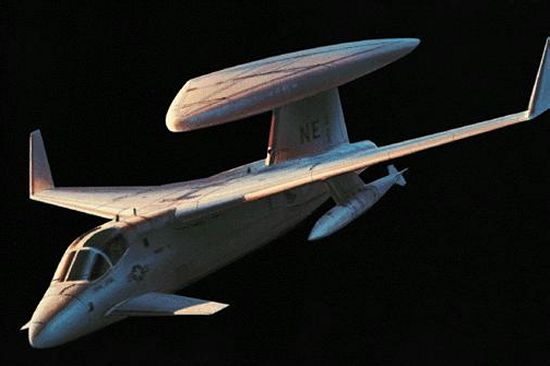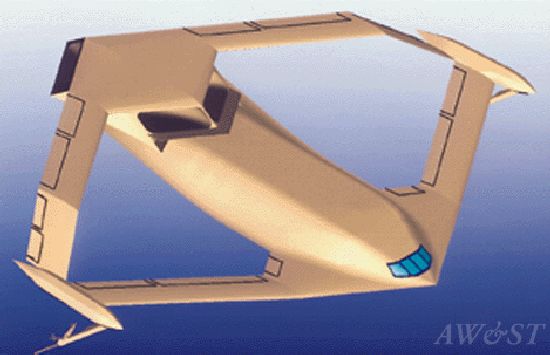|
||||||||||
|
|
||||||||||
|
||||||||||
|
|
||||||||||
The Common Support Aircraft design study was initiated in 1993 to evaluate the possibility of developing a single carrier-borne aircraft that could replace the E-2C Hawkeye airborne early warning (AEW) platform, C-2A Greyhound transport, S-3B Viking anti-submarine and aerial refueling plane, and the ES-3A Shadow surveillance aircraft. Each version of the design would be fitted with a different set of avionics, sensors, and mission-specific equipment suited to the particular role, but the basic airframe would be the same for all aircraft. Initial plans called for the CSA to begin entering service around 2012 to 2015, identified as the timeframe when the legacy aircraft will no longer be adequate.
Phase I of the CSA study focused on defining the mission requirements the new plane should meet, and this effort was completed in 1997. Phase II then proceeded to explore the feasibility of combining all these varying missions into a single airframe. Lockheed Martin has participated in this latter phase and studied a number of concepts that could potentially meet the requirements. The first of these was a conventional design based on the existing S-3 and mounted a radome atop the vertical tail. A more advanced version of this concept incorporated a triangular-shaped radome and faceted surfaces to help reduce the radar cross-section of the design.

A more sophisticated approach called for a fully-faceted stealthy shape equipped with a joined-wing, sometimes also referred to as a diamond wing or box-wing. This design philosophy features two separate wings, one being swept back and the other swept forward, that are joined at their tips creating a continuous structure. Such a shape could be well-suited to tanker duties, since refueling equipment could be mounted at the two wingtips, as well as to AEW missions, since conformal sensor arrays could be attached to the two wings to achieve 360° coverage. Another advantage of the idea is that the two wings create the same lift with a much smaller wingspan than a conventional wing thereby saving precious space on an aircraft carrier.

Lockheed's final design concept called for an unmanned aerial vehicle (UAV) with advanced stealth characteristics.
However, the pace of CSA development has slowed dramatically in recent years and little new information on the project has emerged since about 2000. At first, the Navy had delayed further efforts to ramp up work on the new aircraft citing potential budget shortfalls and the need to address more important priorities. But more recently, it sounds as if the CSA program may have been abandoned altogether. A particularly noteworthy event was the 2000 Tailhook Convention, an annual conference of Naval aviators and brass, where a panel of three-star admirals presented its proposals for the carrier air wing of the future. The group, led by Vice Admiral John Nathman, was not keen on the CSA concept. Chief among their arguments against it were the difficulties in trying to pack so many competing and conflicting missions into a single airframe and the exorbidant costs of developing it, estimated at $22 billion.
In its place, Nathman's group called for the continued purchase and upgrade of the E-2 and C-2 keeping the two aircraft in service for at least two more decades. They also recommended retiring the S-3 in 2008 and transferring its anti-submarine and surface attack duties to helicopters and the F-18 Hornet. The airborne refueling mission will most likely be transferred to the F-18E/F Super Hornet since the Navy has advocated fitting at least some of these multi-role fighters with the ability to carry buddy-stores. Additional refueling support may be supplied by long-range Air Force tankers. At this point, it remains unclear what aircraft might assume the electronic intelligence duties of the ES-3A, or if that capability will be left to variants of the shore-based P-3 Orion alone.
So while I believe the CSA concept is still alive at this time, it appears to be a very low priority that is not likely to ever evolve into a full-scale acquisition program. Those exact sentiments seem to be expressed in the following quote found on an official Navy website dated 23 March 1999:
WE HAVE DEFERRED A FORMAL ACQUISITION PLAN FOR THE COMMON SUPPORT AIRCRAFT (CSA) UNTIL THE CRITICAL ISSUES OF RESOURCES, REQUIREMENTS AND PROGRAM TIMING ARE RESOLVED. IT MAY BE MORE APPROPRIATE TO CALL THE PROGRAM A COMMON SUPPORT CONCEPT (CSC) WHICH ACCOMMODATES OUR EFFORTS TO TAILOR CVW MISSIONS TO THE BATTLESPACE OF THE FUTURE. OUR SUPPORT SOLUTIONS OF THE FUTURE MAY NOT ALL ENTAIL A NEW AIRCRAFT. CURRENT S-3 AND C-2 AIRFRAME TEST ARTICLES WILL FURTHER DEFINE SERVICE LIFE LIMITS AND SLEP ALTERNATIVES. SUPPORT AIRCRAFT PROGRAM INITIATIVES SUCH AS THE E-2 MYP, VERTICALLY CUTTING THE ES-3A, AND SHEDDING S-3B MISSION AREAS HAVE SUCCEEDED IN PUSHING THE REQUIREMENT FOR A COMMON SUPPORT AIRCRAFT FURTHER TO THE RIGHT THAN INITIALLY PROJECTED. TEST ARTICLE RESULTS DUE THIS SUMMER WILL HELP TO DEFINE OUR PATH AND OPTIONS IN MEETING OUR SUPPORT REQUIREMENTS. THE VISION FOR CSA IS TO USE POM02 FUNDS TO START ANALYSIS OF ALTERNATIVES (AOA) AND ROLES AND MISSIONS STUDIES TO SOLIDIFY THE REQUIREMENTS FOR A CSA PLATFORM. THE CONCLUSIONS OF OUR ANALYSIS WILL BE USED TO ESTABLISH A ROADMAP AND THEN MOVE FORWARD WITH THE MODERNIZATION OF NAVAL AVIATION’S SUPPORT AIRCRAFT INVENTORIES.
Let's now address your second question about how pilots are transferred from an aircraft that is being phased out to a new design. Typically, a new aircraft is first built in prototype form and goes through several years of developmental flight testing at dedicated research facilities like Edwards Air Force Base and Naval Air Station Patuxent River. These flights are conducted by dedicated flight test pilots based at those facilities. Once an aircraft has progressed to the point where it is ready to go into operational testing, the military service selects one or two operational squadrons to conduct the transition. As you hypothesized in your question, these squadrons typically already operate whatever aircraft is being retired. These pilots are therefore the first front-line, active-duty pilots to begin using the new plane. This phase of the process evaluates training and maintenance procedures and insures that the new plane is suitable to go into wide-spread service.
Probably the most recent American military aircraft to go through this process was the Navy's F-18E/F Super
Hornet. While flight testing began at Pax River in 1995 with initial sea trials in 1996 and 1997, the first
operational squadron was not established until 1999 at
Naval Air Station Lemoore. The squadron, VFA-122, was
established to assist test pilots at
Naval Air Weapons Station China Lake in conducting OPEVAL
and to train Super Hornet flight instructors. The first operational group of F-18E/F crews is made up of former
pilots of the F-14 Tomcat, one of the platforms being replaced
by the Super Hornet. Meanwhile, the Air Force's
F-22 Raptor
is due to enter OPEVAL by 2004 or 2005 with the first operational squadron being
F-15 Eagle
pilots from the 1st Fighter Wing at
Langley Air Force Base.
- answer by Jeff Scott, 25 August 2002
Read More Articles:


|
Aircraft | Design | Ask Us | Shop | Search |

|
|
| About Us | Contact Us | Copyright © 1997- | |||
|
|
|||